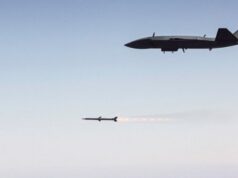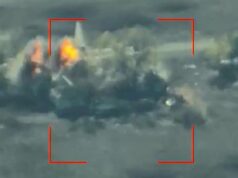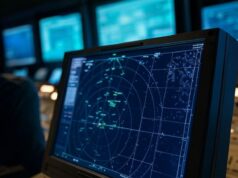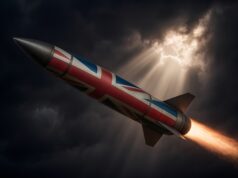At DSEI 2019, Leonardo displayed its latest-generation medium-lift AW149 helicopter.
The firm say that the aircraft is rapidly configurable to meet a wide range of military missions:
“Troop transport/troop insertion (carrying up to 16 fully-equipped troops or up to 19 passengers), cargo re-supply/external lift, CASEVAC/MEDEVAC, search and rescue (SAR), Special Forces operations and combat SAR, Command and Control (C2), and close air support.”
Leonardo is pitching the twin-engine AW149 to customers around the world which are considering replacing their fleets of ageing multi-mission helicopters and it could be an ideal solution for the UK say the firm.
According to a release:
“In line with this strategy, the AW149 is designed to meet the operational needs of military commanders with excellent levels of safety and survivability and attractive through-life costs. Features such as 4-axis autopilot, advanced open system avionics architecture and large sliding doors for ease of access for troops and equipment make the AW149 an ideal candidate to replace legacy platforms as they go out of service.
The twin engine type features excellent hot & high performance and a max cruise speed (ISA, MTOW, SL) of 287 km/h 155 kt.”
According to a specification sheet:
“The multi-role military helicopter can carry a variety of armaments such as: 2 x 7.62 mm/2 x 12.7 mm machines guns (internal), 2 x 20 mm gun pods, 2 x 12.7 mm gun pods, 2 x 2.75” rocket launchers and 2 x ATM launchers. Tailored payload and weapon system solutions are available thanks to the modern open architecture design. The AW149 is designed to carry a host of weapons and stores on external carriers and on the window gun mount.”
Presented with the aircraft at DSEI 2019 is an integrated replica sensor suite which includes the Osprey radar, SAGE electronic support measures (ESM) and a MAIR missile warner. The Leonardo sensors are representative offerings forming part of an integrated Defensive Aids Suite (DAS).













Would be a potential replacement for the Puma, I presume, if we still have any? I very rarely see medium airlift these days, photos are all either Chinook or Wildcat (which I believe is smaller). I’m deliberately Keeping Merlin out of the equation, because I think they should all be maritime platforms; if they’re so expensive that we can only get them in limited numbers then best put them where they’re best suited.
Very much so. 33 and 230 Sqns, with 28 as the OCU.
Hi daniele
Hope all is well
I have been at DSEI all week, great event – lots to see.
However, I also encountered a civilian helicopter sprayed green with some add on’s.
I have never been a big supporter of the Puma Mk2, however as an operator I know which aircraft I would rather get in when rounds start rattling around.
Great concept, but the Blackhawk is still – leaps and bounds ahead of the rest, this doesn’t even come close.
To caveat however, as an SF insertion platform…..
Lee. Morning.
Thanks for this observation. 657 was chopped and never replaced as far as I’m aware. There was a programme to replace with a small number of converted Wildcats diverted from the 34 army order, which seems to have vanished.
Have you had a look at the southern end of Credenhill lately on the latest 2018 images on GE, next to the old 8 Flights pad? I’m curious.
They’re operating on Afghan.
Manufactured in Britain…an ideal aircraft for a number of military applications. Should be the mainstay of AAC…and providing all round support for the RAF. I have championed this aircraft for the last 6 years…it makes sense in terms of its affordability, its multi-role capability and future development possibilities!
However, it might not make sense for long term strategic capabilities, if MoD are looking at what develops from the US Future Vertical Lift program, for AAC, RAF and and perhaps FAA in due course. Developments from the technology demonstration Bell V-280 Valor and SB>1 Defiant programs may provide sea change capabilities for rapid, long distance deployment.
FVL may get too expensive and/or delayed for UK use (or perhaps isn’t even under consideration), but especially if the UK sees itself plugging in alongside the US to address a potential Tier 1 confrontation in Norway or the Baltics, then FVL is a logical option.
What should replace the gazelles?
Wildcat is a good replacement for gazelle. Frankly thats what it should be used for.
Wildcat needs an upgrade to turn it into the recce helicopter it should have been, I would add roof mounted sight & osprey radars plus Spike nlos & LMM (the nose mounted camera is great but still requires breaking cover.. It’s too expensive for a gazelle replacement. I think H149m would be a brilliant addition to replace the gazelle giving, not only utility, but also Special Force urban ops & possibly light attack capability. For Puma replacement if we’re being ambitious V280 valour or unambitious either this or NH90 (if kinks ironed out)
As much as I believe the Puma2 was the wrong decision at the time, I’m struggling to find the rationale behind replacing it with the AW149 or the Blackhawk? The Blackhawk, AW149 or NH90 are good helicopters but how are they any better than the Puma? All of these helicopter have about the same payload, range and speed, Where is the advancement?
The US Army has the right idea with its future medium lift competition. Setting the aircraft’s minimum speed at 250kts was genius, it means that the companies had to push the boundaries and come up with a solution. One of these two aircraft either the SB1 Defiant or V280 Valor are perhaps what is required to replace the Puma.
You are forgetting the key factor…price! There is little indication that we are going to acquire even a small number of Tilt-Rotors for our carriers. I can’t see the MOD funding exotic fast choppers!
It does seem to tick a lot of boxes, I would however say that with the relatively small number of medium lift helicopters required, we need to consider maintenance costs and the maximum flexibility of a type, to fully utilise them.
To me, that means buying another 25 ( fully marinised ) MK4 Merlin’s for the RAF to replace the Puma.
I know they are at the top end of medium lift, but it makes a lot of sense to have a ramp, carry more troops and kit and deploy to sea when necessary.
The fleet would cost more to aquire, but would offer far greater flexibility…
According to Bell, their V280 should be at the same price as a MH60 Blackhawk, so that’s cheaper than a Merlin. This was another of the US Army’s requirements, in that the replacement aircraft should be about the same price as the existing aircraft.
The US Amy’s Future Vertical Lift – Medium is also being paid for by the US Navy. They have a requirement to replace their Seahawks, but also to replace the USMC’s Hueys. However, wins the competition between Bell and Boeing/Sikorsky will have work for at least the next 20 years. There are over 4000 aircraft that require replacing between the services (I am not including attack, liason or scout helicopters, as that’s a different requirement.)
I am pretty sure the MoD will do the same as they have done recently with the Apache E and new buy Chinooks. By buying the aircraft directly from the US Army rather than the manufacturer. This works out cheaper as our order is then added to theirs, thus decreasing the price due to bulk buying (maybe!). The problem with this is yet again we buy from another country, rather than developing our own.
The Puma 2 is due to go out of service in 2025. The MoD have not announced that they are looking at a replacement, so I’d expect this date to slip to the right. If it slips to 2030, I believe this is the planned in-service date for the new US aircraft. As a small note – Bell and Leonardo have a manufacturing agreement with tilt-rotors as they both had a part in the design of the AW609. If the Valor wins, I would like to think an agreement can be made to build them in Europe i.e. Yeovil.
I hope this isn’t being considered by the uk
We need to standardise on Merlin and get that fleet doubled, then focus on a tilt rotar capability.
I also have no problem with jumping the Merlin bit and going straight to next Gen.
We cant afford another type, we need to replace the Gazelle and Puma fleet and I would like to see this done with Merlin.
We then push an all Merlin fleet into the RN, replace the Gazelles with the RN’s wildcats and the RAF are left with chinook. At the end of the day its a joint helicopter force but we need to ensure all Merlins are marinised.
I would even suggest swapping the gazelles out for more apaches, as the price we are getting is amazing and it can do the job and more.
Lastly we need to get a load of Schiebel 100 UAV’s or similar and get some mass into this space.
Doesn’t the Navy need the wildcat, big Merlins aren’t always suited for Navy missions.
The issue is wildcats don’t have tipping sonar or the endurance to do sub hunting, which means their usefulness in a shooting war is fairly limited to dropping torpedos /deathcharges after the frigates sonars find the subs.
What i don’t get is why we haven’t invested in missile based torpedeos, removing the need for the helicopter.
Quite possibly Cam, but this was the RN’s original plan and the fact is Merlin is world class and cheap, and we don’t have enough of them and Wildcat is massively expensive.
My proposal is a way of increasing capability and like all things it is a compromise, but ultimately as its a joint helicopter force the ability remains to role as required.
one other point is that the RN in particular need to get a Scheibel UAV in service in massive numbers and I do have an image in my mind that Boxer will have four Quadcopter on its roof that they can deploy for localised ISTAR purposes (but that really is me making shit up)…
Wildcat is a useful aircraft. Its great for fighting of light vessels in the littoral environment.
Not denying that Harry and that can still be the case. I am proposing shuffling the cards to get more Merlins as that is the sweet spot
You can buy almost 2 Merlins for 1 wildcat. It really is about resource management for me and we can replace puma and gazelle with Merlins if we move the wildcat into the gazelle role
should we replace the gazelles and pumas with a single type to save money? I’m not sure this is the right fit, but what would be? But these could secure lots of work in the UK factory for years!.
But No doubt we will lose another huge chunk of our helicopters in the near future with this decision.
Cor, if only.
Gazelle is no longer a front line type and will probably be replaced by a COMO type, or nothing at all.
Puma. I’d buy more Merlins but the RAF no longer operates the type and did not like it so some say.
Probably built in Italy. Leonardo wheel this out at every show. Its never sold not even in its civilian guise. A new approach is needed, anybody remember that troop carrier in Starship Trooper? get designing Leo !!
Not true…AW149 is operated by Egypt and Thailand!
Oh and its commercial version, the AW189, is operated by numerous organisations/countries. Bristow use them for offshore oilfield work and the coast guard!
5 to thailand and a proposed 20 to egypt. remember the Lynx sale to egypt?. The 149 is very much a civilian helo painted green.!! Sorry i just dont rate it. and as for manufacture set up in the UK. i wouldnt trust Leo, but then i did work at yeovil for many years
l
The 149 is a great platform, developed from the 139, which was itself intended as contender for the Huey replacement market. Its very similar to the 189, which is a civilianised version and used by HM Coastguard for SAR. However as far as UK is concerned the Puma upgrade programme and transfer of Merlins to the RN probably put paid to any new medium weight helicopters in the near term, and the RAF and RN will probably want to wait for the next generation of technology and combine Merlin and Puma replacement into one requirement. Of course a niche might arise – the RN’s FOST flight and the AAC SF squadron use some ageing AS365 Dauphins, and the utility-SAR B412 Griffins at Akrotiri will need replacing some time soon. One area where I see a requirement is for a utility helicopter to operate from the RFAs in the onboard delivery and SAR function. In the 1970s to 90s numbers of Wessex and early Seakings were re-roled for this task by the simple expedient of stripping out their ASW suite as newer variants came along. We are currently asking the Merlin HC4s to take on this task, but it seems a waste of expensive and scarce resources better suited to combat roles. A PFI or contractor could do the trick, with something like AW149 or another type currently deployed in the offshore support role.
Leonardo have made it clear if the uk buys this to replace puma, it will move the production line from Italy to the UK.
Thats really important as we need an exportable medium lift for protecting sovereign rotor. The two lines we have at the moment are both niche navy rotors.
The AW149, is in all ways better than a previous generation medium lift rotor like the Blackhawk, is in itself in line to be the next US medium rotor and has already been exported to 2 other nations.
It’s a new but tested airframe, that sits in the exact size the army wants, would be build in the UK, gives us the export market ( apart from US if it takes it). What’s not to like.
Why is the AW149 better than the Blackhawk? Does it have the built in armour protection for the tail rotor drive line like the Blackhawk?
It’s got greater range and carriers a greater load and is a touch faster. It’s also got some of the best crash protection out there. The Blackhawk is getting on to be a 50 year old design, why would go for a fifty year old airfame design over a 21 century one. It’s also armoured has self sealing tanks all the defence aid expected. It’s not a civilian helicopter painted green as some have commented, it is designed as a military rotor and the civilian version the 189 came into well after the 149.
The big difference between the Blackhawk and AW149 are in the touch down sink rates ( speed of landing before you bust it) that the landing gears are designed for.
The black hawk is as I understand it designed for a max landing with a sink rate of 540feet per minute which runs at around 2.75 m/s ( this is not great and is probably a by product of age of design).
The AW149 is as I understand Is designed around landing at up to 9.5m/s and still being in a fit state (I would take this with a pinch of salt as you average landing will be at no more that 2 m/s).
We are very short of helos for the AAC, especially medium lift. For a fonce of 6 combat brigades, which the UK will have, the US Army would provide 460 helos, 240 of them front line. Leaving aside the Gazelles and Bell 212s, we have just 133, I. e. about 30% of the necessary establishment. And 49 of them are not necessarily available to the AAC, the 24 Puma’s are tasked by the RAF and first call on the 25 Merlin HC4s is 3 Cdo Bde.
The Government is conning its way round the issue as always, with the SDSR stating that the aim is to deploy one division/3 bdes, so now we are only planning to support half the army.
The correct helo strength for that sole division would be:
Attack – Apache – 45
Combat Recon – Wildcat – 48
Air Assault – Medium lift helo – 58
Command/EW – Medium lift helo – 15
Medivac – Medium lift helo – 19
Heavy lift – Chinook – 23
UAV – Watchkeeper – c 20
These figures include reserves and OCUS.
So, we have enough Apaches and Chinooks but are short of 14 Wildcat and 97 medium lift helos. The 40-year-old Pumas could do the medivac role until their OSD in 2030-something, reducing the medium lift shortfall to 73.
The air assault task needs a fast, reliable helo that can carry troops or supplies, it does not need to be a world-beating state-of-the-art design. The AW-149 would fit the bill if the price is right. It has the advantage of carrying a platoon in 2 flights, rather than the 3 required with Black Hawk, so can do the same job with fewer air frames.
We have a great capability gap here and cannot afford to wait for some future US longer-range design. Arguably, longer range is not a key requirement on the battlefield, longer range excursions would be by Merlin and Chinook.
As AW are willing to transfer the production line to Yeovil, we should jump at the chance to get Westland back producing helos and look at putting a more powerful RR engine in it and increasing range and speed.
Wildcat may be expensive but it is a very good fit for the combat recon role. We should order 14 more to get up to establishment. It will be in service for the next 2 decades, so there is no chance we will switch to the US recon aircraft still on the drawing board.
Jonathan and James, I completely agree with your support for the AW149. Getting the production line in this country with an army/Raf order would be very good news!
So would you say its as good or on par with the NH90?
I agree, 149 is a specifically designed military platform, I should have made that clear too. It was in the running for the Polish SF C-SAR buy, but in the end they went for Blackhawks assembled by PZL and bought Merlin’s for the navy from Leonardo/Sokol – which was probably politically motivated to spread the work around Polish industry.